Rhetoric is the use of persuasive language utilising compositional and linguistical tricks and techniques to impressive effect. However probably due to a reliance on ‘figures of speech’ and well-worn cliché, it is betrayed by its lack of “sincerity or meaningful content”(1)

Williams study(2) of Utopian frames found that game presentation included the enhancement of physical skill, for example in spatial ability, violence as catharsis(3) , games as educational and games as good displacement. In the latter he cites Langway’s studies(4) which found the arcade functioning as a community, a peaceful one which encouraged bonding through a mixed and otherwise tense set of communities. I found this myself amongst the arcades in Northern Ireland. The second wave(5) of positive media rhetoric from the games industry and its supporters too; these aspects included videogames potential to build intelligence(6) , to be in themselves enjoyable, to create and power a social environment(7) and to foster and encourage the sponsorship of technoliteracy(8) . This frame was somewhat reactive and defensive yet nevertheless served as an important pre-emptive move to a predictable strike by tabloid reaction that really only took up the opposite of these. Williams’ frames concept is by Wartella and Reeves(9) and upon application of the Dystopian frames found again two waves – the first consisting of health risks, theft, drug use, and activity displacement. This was a noteable point in that it deprived gamers of other more worthwhile uses of their time(10) and it also deprived them of the use of their money too(11) . The second wave identifies games as a health risk with all media-constructed physiological diagnoses for problems with players wrists, hands and the more worrying but also very rare stimulus to epileptic seizure. It also identified video games as promoting violence, and other social risks, including perceptual difficulties, short attention spans(12) and gamers and journalists both indulging in a language of pathology.
Doom has been particularly pulled out by the tabloid media for its referencing in discussions between the Columbine murderers(13) . Doom-maps are focussed in on, both in pencil form in the boys relation to their activities at the school, and at home in the form of WADs. It is interesting that mainstream media seem to have overlooked this huge phenomenon(14) of a global spike of numbers of games programmers, an interactive trip, which became a seriously intelligent hobby and no doubt stimulated a number of careers and important social bridges(15) . Tabloid press tends not to focus on videogames cultural milestones as newsworthy, and nowhere there have I found rhetoric employed to mention the enthusiasm for Doom, Doom WADding, first person shooters in the context of architectural measurement, bridges between the environments of home and arcade. Nor does this sort of rhetoric recognise the finesse of information relating to pumpkin smashing, or show any ability to observe what the game awoke in people to inspire them to create, and find audiences for comic strips, cartoons, videos, novels, clone games and pieces of music.
(Word Count: 496)

References
(1)
Oxford English Dictionary(2)Williams, Dmitri (2003a).
The Video Game Lightning Rod: Constructions of a New Media Technology, 1970-2000. Information, Communication and Society, 6(4), pp. 523-550. Retrieved 10 March 2007 from https://netfiles.uiuc.edu/dcwill/www/DWICS.pdf
(3)
‘The Asteroids Are Coming’ (1981) Newsweek, 23 February.
(4)Langway, L. (1981)
‘Invasion of the Video Creatures’, Newsweek, 16 November.
(5)The first wave is discussed on pages 537-538 and the second wave on pg 539
(6)Lord, M. (2000)
‘Just One More, I Promise’, US News & World Report, 27 November.
(7)Taylor, C. (1999b)
‘Dream Machine’, Time, 2 August.
(8)Loftus, E. (1984)
‘Being Hooked on Videogames Can Be Good for Your Kids’, US News & World Report, 20 February.
(9)Wartella, E. and Reeves, D. (1983)
‘Recurring issues in research on children and media’, Educational Technology, 23: 5–9.
Wartella, E. and Reeves, D. (1985) ‘Historical trends in research on children and the media: 1900–1960’, Journal of Communication, 35: 118–33.
(10)Elmer-DeWitt, P. (1993b)
‘Too Violent For Kids?’, Time, 27 September..
(11)Skow, J. (1982)
‘Games That Play People: Those Beeping Video Invaders are Dazzling, Fun – and Even Addictive’, Time, 18 January.
(12)Meyer, M. (1998)
‘Just Don’t Shoot the Client. How Do You Train Nintendo-Generation Workers?’, Newsweek, 30 November.
(13)
4-20: a Columbine site. Basement Tapes: quotes and transcripts from Eric Harris and Dylan Klebold's video tapes. Retrieved on March 10th, 2005. http://columbine.free2host.net/quotes.html
(14)Wikipedia on Doom and Doom WADs. Retrieved on March 10, 2007 at http://en.wikipedia.org/wiki/Doom and http://en.wikipedia.org/wiki/Doom_WAD
(15)“Several thousands of WADs have been created in total: the idgames FTP archive contains over 13,000 files, and this does not represent the complete output of Doom fans.” Retrieved on March 10, 2007 at http://en.wikipedia.org/wiki/Doom











